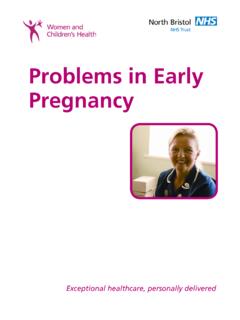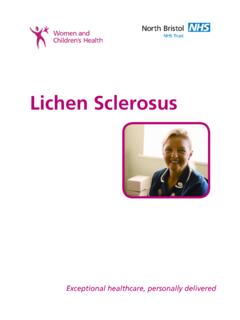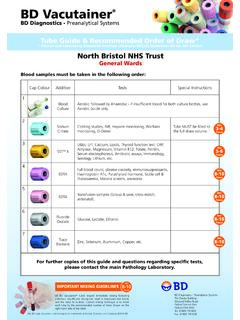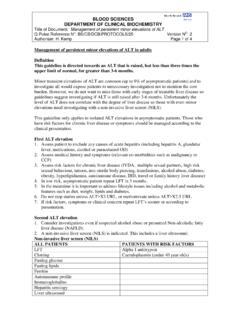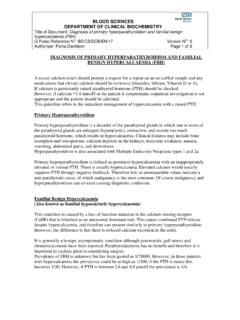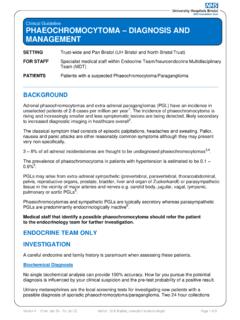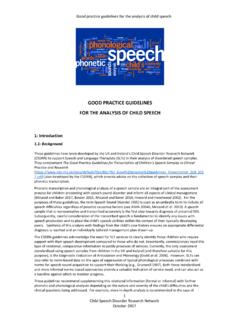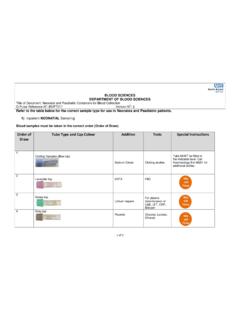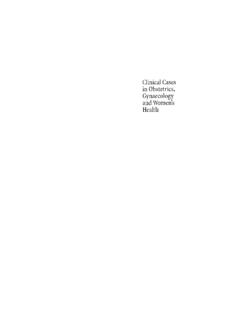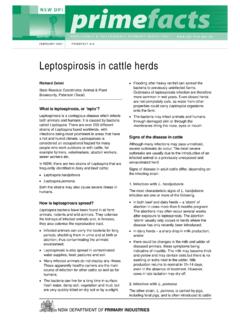Transcription of Antibiotic Guidelines 2020 - North Bristol NHS Trust
1 Antibiotic Guidelines 2020 These are empirical Guidelines treatment should be reviewed clinically at 48-72 hours with the results of clinical findings, pathology and imaging results, and microbiological cultures. Antimicrobials can then be stopped, switched to oral therapy, changed to a narrow spectrum agent or continued with further review. Updated 27th March 2020 Lower Respiratory Tract Infections SECTION and COVID-19 ADDENDUM Main Authors: AP MacGowan, ESR Darley, SK Jacobson, D Smith and J Urch on behalf of the Antibiotic Sub Group of the DTC. Date of Issue: July 2015, Version July 2016, Version January 2017, version September 2017, version July 2018 Ratified by the Drugs and Therapeutics Committee: July 2018 Date of Review: July 2020 Click here to return to contents page NBT Antibiotic Guidelines July 2018 2 Contents Page Quick Link Introduction and contact information 3 here 1.
2 Prescribing Information 4 here 2. Treatment Guidelines Gastro-intestinal 7 here Lower Respiratory Tract Infections 8 here Central Nervous System 13 here Urinary Tract 14 here Blood 16 here Neutropenic sepsis 17 here Skin 19 here Diabetic foot infection 20 here Hepatology 20 here Eye 21 here Ear, Nose and Throat 21 here Endocarditis management 22 here 3. Antibacterial Prophylaxis Guidelines Non-surgical 23 here Surgical 23 here 4. Pathogen Specific Treatment Guidelines Clostridium Difficile 29 here MRSA 31 here Invasive Fungal Infection 31 here 5. Discipline Specific Guidelines Neurosurgery 33 here Burns and Plastics 38 here Richard Bright Renal Unit 39 here Hot Orthopaedic/Trauma 43 here Obstetrics and gynaecology 44 here 6. Dosing Information Gentamicin 45 here Amikacin 46 here Vancomycin 47 here 7. Assessment of Penicillin Allergy 48 here 8.
3 Further Information, References and Glossary 50 here Appendix A. Splenectomy vaccination policy 51 here Appendix B. Renal dosing of antibiotics 53 here Click here to return to contents page NBT Antibiotic Guidelines July 2018 3 INTRODUCTION This document outlines the antimicrobial Guidelines for North Bristol NHS Trust . The Guidelines are designed with the specific objective of reducing to a minimum the use of cephalosporins, fluoroquinolones and co-amoxiclav. These agents have been implicated as risk factors for the acquisition and infection with multidrug resistant bacteria such as MRSA and ESBL producing and Klebsiella species. In addition, they have been associated with increased risk of infection with Clostridium difficile and associated diarrhoea. The Guidelines are based on policies used by other NHS Trusts in England to reduce the risk of these infections as well as data from Scandinavia and The Netherlands where hospital infections due to multi resistant bacteria and are much rarer than in English hospitals.
4 It follows therefore that these recommendations are not always based on national Guidelines either published in the British National formulary or by professional societies. In most cases, the Guidelines have been developed by infection specialists and the relevant clinical specialities. The Guidelines should not be used in isolation but be cross-referenced with relevant specialty protocols, and also the Trust Infection Control policies, Microbiology User Guide and the Antibiotic Prescribing Policy. These are all available on the Microbiology homepage on the Trust Intranet. This document can be found at: http://homepage/Clinical_Support/Patholo gy/New%20 Pathology%20 Main%20 Page/ INFECTION SCIENCES DEPARTMENT ( medical MICROBIOLOGY) CONTACT DETAILS Tel: 46206 Bleep: 9446 Lead Pharmacist Anti Infectives Bleep: 1281 Click here to return to contents page NBT Antibiotic Guidelines July 2018 4 Switching from intravenous to oral therapy Treatment which is initially administered by the parenteral route should be switched to the oral route as early as possible according to the following criteria.
5 Where IV antibiotics are continuing beyond 72 hours there must be a reason stated in the notes. temperature <38oC for 24 hours and improvement clinically and in blood biomarkers of infection patient able to tolerate oral food and fluids absence of ongoing or potential problem of absorption required Antibiotic concentrations can be achieved by oral therapy oral formulation or suitable alternative is available Suggested options for oral step down therapy are listed in the table below. IV therapy oral step down therapy amoxicillin amoxicillin amoxicillin + gentamicin + metronidazole co-amoxiclav azithromycin azithromycin clindamycin clindamycin co-trimoxazole co-trimoxazole co-trimoxazole + metronidazole co-trimoxazole + metronidazole ceftriaxone consult a medical Microbiologist flucloxacillin flucloxacillin gentamicin ciprofloxacin, co-trimoxazole or co-amoxiclav (pivmecillinam, nitrofurantoin or trimethoprim may be suitable for a simple UTI) meropenem consult a medical Microbiologist piperacillin-tazobactam vancomycin If a decision is made to continue with IV antibiotics then the rationale for this should be clearly recorded in the medical here to return to contents page NBT Antibiotic Guidelines July 2018 Recommended Durations of Antibiotics Antibiotic courses should comply with the following durations.
6 Any exception should be documented in the medical notes. Indication Length of course GI Peritonitis 5 days appendicitis 5 days pancreatitis Not recommended diverticulitis 5 days Biliary tract infection 5 days Typhoid fever 7-14 days Gastro enteritis not usually indicated Oesophageal rupture Discuss with a medical Microbiologist Antibiotic associated colitis 10 days Peritoneal dialysis associated peritonitis 14 days peritonitis in patients with liver cirrhosis 5 days Prevention of infection in upper GI haemorrhage 5 days Chest CAP high severity 5 days CAP moderate severity 5 days CAP low/mild severity 5 days Acute exacerbation COPD 5 days Aspiration pneumonia 5 days HAP 5 days acute exacerbations of bronchiectasis 14 days CNS Meningitis 7-10 days Brain abscesses, neurosurgical infections Discuss with a medical Microbiologist Uro-genital Uncomplicated UTI Males: 5 days, females: 3 days Complicated UTI 5 days Acute Pyelonephritis 7 days Epididymo-orchitis 10 days Prostatitis 28 days Sepsis Sepsis Depends on source - discuss with a medical Microbiologist Neutropenic sepsis 7 days Skin, soft tissue and bone Cellulitis/ erysipelas 5 days Animal and human bites 5 days Wound infection following clean surgery 5 days Wound infection following contaminated surgery 5 days Perianal infection/abscess 5 days Cellulitis at a cannula site 5 days Cellulitis in a current injecting drug user 5 days mastitis and breast abscesses 5 days Diabetes mellitus foot infection 7-14 days Burn Wound Infection 5 days, 3 days if no pathogen isolated Limb Abscess 7 days Necrotising fasciitis Discuss with a medical Microbiologist Prevention of infection during leech therapy duration of contact Click here to return to contents page NBT Antibiotic Guidelines July 2018 6 Open fracture 72 hours or until soft tissue closure.
7 Whichever is sooner Septic arthritis 4 weeks in total (5-7 days IV, remainder PO) Acute Osteomyelitis not related to prosthetic joints minimum 6 weeks in total (5-10 days IV, remainder PO); Orthopaedic infections with metalwork in situ Discuss with a medical microbiologist Cardiovascular Endocarditis Discuss with a medical Microbiologist Obs & Gynae Pelvic Inflammatory Disease 14 days Third or fourth degree perineal tears 5 days Manual removal of the placenta 5 days Hysterosalpingitis 7 days Post op wound infection 5 days Click here to return to contents page NBT Antibiotic Guidelines July 2018 72. TREATMENT Guidelines Suggested treatments are given below. They apply to adult patients with normal renal function. When the pathogen is isolated, treatment may be changed to a more appropriate antibacterial if necessary. If no bacterium is cultured the antibacterial can be continued or stopped on clinical grounds. Gastro-intestinal system Review antibiotics at 48-72 hours.
8 Therapy should be amended once a definite pathogen has been identified. IV antibiotics can be de-escalated once IV/oral switch criteria are met. Stop antibiotics if infection has been ruled out. Record all decisions in the notes. State the duration and indication on the drug chart. Peritonitis amoxicillin 1g TDS IV + gentamicin IV (see section for dosing) + metronidazole 500mg TDS IV for 5 days Penicillin allergy: co-trimoxazole 960mg BD + metronidazole 500mg IV TDS + gentamicin IV If the patient s eGFR is <20ml/min, please discuss with a medical microbiologist. If there are concerns with the use of gentamicin, please discuss with a medical microbiologist. Do not just omit the gentamicin, an alternative is required. oral step down: co-trimoxazole 960mg BD + metronidazole 400mg TDS Patients at high risk of emergency laparotomy Co-trimoxazole 960mg IV BD + metronidazole 500mg IV TDS for 5 days appendicitis amoxicillin 1g TDS IV + gentamicin (see section for dosing) + metronidazole 500mg TDS IV for 5 days oral step down: co-trimoxazole 960mg BD + metronidazole 400mg TDS If the patient s eGFR is <20ml/min, please discuss with a medical microbiologist.
9 Pancreatitis Not recommended. Consult a medical Microbiologist diverticulitis amoxicillin 1g TDS IV + gentamicin (see section for dosing) + metronidazole 500mg TDS IV for 5 days penicillin allergy: co-trimoxazole 960mg BD + metronidazole 500mg IV TDS + gentamicin IV oral step down: co-trimoxazole 960mg BD + metronidazole 400mg TDS; or co-amoxiclav 625mg TDS If the patient s eGFR is <20ml/min, please discuss with a medical microbiologist. Biliary tract infection (cholecystitis/cholangitis) gentamicin (see section for dosing) for 5 days oral step down: ciprofloxacin 500mg BD If the patient s eGFR is <20ml/min, please discuss with a medical microbiologist. H pylori eradication Clarithromycin 500mg BD + metronidazole 400mg TDS + omeprazole 20mg BD for 7 days; or amoxicillin 1g BD PO + clarithromycin 500mg BD PO + omeprazole 20mg BD PO for 7 days Typhoid fever ceftriaxone 2g BD IV and ciprofloxacin 400mg BD IV/ 750mg BD PO Click here to return to contents page NBT Antibiotic Guidelines July 2018 8 Infection from the Indian subcontinent, Middle East and South East Asia may be multiple antibacterial resistant Ongoing management should be discussed with an Infectious Diseases Physician or medical Microbiologist Gastro enteritis antibacterials not usually indicated Oesophageal rupture Co-trimoxazole 960mg IV BD + metronidazole 500mg IV TDS + fluconazole 400mg IV OD for 5 days Clostridium difficile associated colitis See chapter (page 33) Peritoneal dialysis associated peritonitis See renal policy.
10 Oral candidiasis Nystatin mouthwash 100,000units QDS for 7 days or fluconazole 50mg OD PO for 7 days Oesophageal candidiasis Fluconazole 100mg OD PO for 7 days Click here to return to contents page NBT Antibiotic Guidelines July 2018 Lower Respiratory Tract Infections Community acquired pneumonia (CAP) Diagnosis Pneumonia is typically an acute febrile illness with cough, breathlessness, often productive of sputum and pleurisy in a patient with or without existing chest disease and new shadowing on chest X-ray. Pneumonia is defined as community-acquired if it presents prior to or within 48 hours of admission. Initial Management - use an ABCDE approach when assessing acutely unwell patients Patients should receive appropriate oxygen therapy with monitoring of oxygen saturations as per NBT Guidelines Patients should be assessed for volume depletion and may require intravenous fluids Order bloods (FBC, U&Es, CRP and LFTs) Ensure a chest x-ray is performed within 4 hours Start antibiotics within 4 hours or within 1 hour if sepsis present Mortality Score The CURB65 score should be used and documented in the patient s notes to assess the severity of pneumonia.
